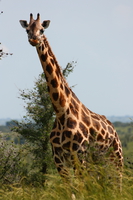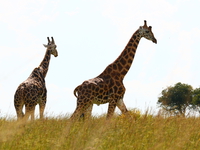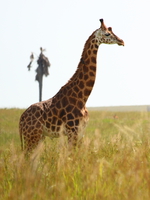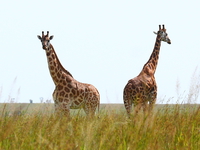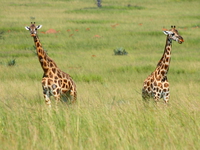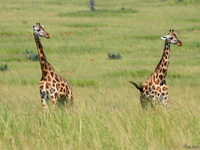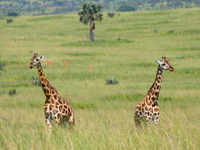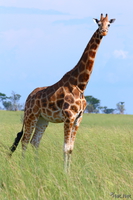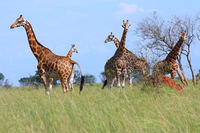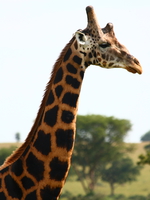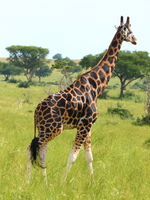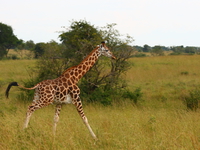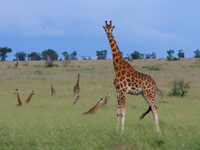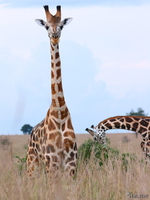giraffes of uganda
The giraffe (Giraffa camelopardalis) is an African even-toed ungulate mammal, the tallest of all land-living animal species. Males can be 4.8 to 5.5 metres (16 to 18 feet) tall and weigh up to 1,360 kilograms (3,000 pounds). The record-sized bull was 5.87 m (19.2 feet) tall and weighed approximately 2,000 kg (4,400 lbs.).[2] Females are generally slightly shorter, and weigh less than the males do.
The giraffe is related to deer and cattle, but is placed in a separate family, the Giraffidae, consisting only of the giraffe and its closest relative, the okapi. Its range extends from Chad to South Africa.
Giraffes can inhabit savannas, grasslands, or open woodlands. They prefer areas enriched with acacia growth. They drink large quantities of water, and as a result, they can spend long periods of time in dry, arid areas. When searching for more food they will venture into areas with denser foliage.
Romeo and Juliet is an early tragedy by William Shakespeare about two teenage "star-cross'd lovers" whose "untimely deaths" ultimately unite their feuding households. The play has been highly praised by literary critics for its language and dramatic effect. It was among Shakespeare's most popular plays during his lifetime and, along with Hamlet, is one of his most frequently performed plays. Romeo and Juliet are widely represented as archetypal young lovers.
And no, these two giraffes didn't kill themselves (I hope not), they are just hopelessly in love.
The Rothschild Giraffe, named after Tring Zoological Museum's founder, Lord Walter Rothschild, also known as the Baringo Giraffe, after the Lake Baringo area of Kenya, or as the Ugandan Giraffe, is the most endangered of giraffe subspecies, with around forty believed to exist in the wild. While giraffes in general are classified as Lower Risk: Conservation Dependent, the Rothschild Giraffe is at particular risk of hybridisation, as the population is so limited in numbers. There are very few locations where the Rothschild Giraffe can be seen in the wild, with notable spots being Lake Nakuru National Park in Kenya and Murchison Falls National Park in Northern Uganda. There are various captive breeding programmes in place - most notably at The Giraffe Centre in Nairobi, Kenya, and at Woburn Safari Park in Bedfordshire, England - which aim to expand the genetic gene-pool in the wild population of the Rothschild Giraffe.
Giraffes also have slightly elongated forelegs, about 10% longer than their hind legs. The pace of the giraffe is an amble, though when pursued it can run extremely fast. It can not sustain a lengthy chase. Its leg length compels an unusual gait with the left legs moving together followed by right (similar to pacing) at low speed, and the back legs crossing outside the front at high speed. When hunting adult giraffes, lions try to knock the lanky animal off its feet and pull it down. Giraffes are difficult and dangerous prey though and when attacked the giraffe defends itself by kicking with great force. A single well-placed kick from an adult giraffe can shatter a lion's skull or break its spine. Lions are the only predators which poses a serious threat to an adult giraffe.
Female giraffes associate in groups of a dozen or so members, occasionally including a few younger males. Males tend to live in "bachelor" herds, with older males often leading solitary lives. Reproduction is polygamous, with a few older males impregnating all the fertile females in a herd. Male giraffes determine female fertility by tasting the female's urine in order to detect estrus, in a multi-step process known as the flehmen response.
Giraffes will mingle with the other herbivores in the African bush. They are beneficial to be around because of their height. A giraffe is tall enough to have a much wider scope of an area and will watch out for predators.
Rothschild Giraffes are easily distinguishable from other subspecies. The most obvious visible sign is in the colouring of the coat, or pelt. Where the Reticulated Giraffe has very clearly defined dark patches with bright whitish channels between them, the Rothschild Giraffe more closely resembles the Masai Giraffe. However, when compared to the Masai Giraffe, the Rothschild subspecies is paler, the orange-brown patches are less jagged and sharp in shape and the connective channel is of a creamier hue compared to that oft sported by the Reticulated Giraffe. In addition, the Rothschild Giraffe displays no markings on the lower leg, giving the impression that it is wearing white stockings.

